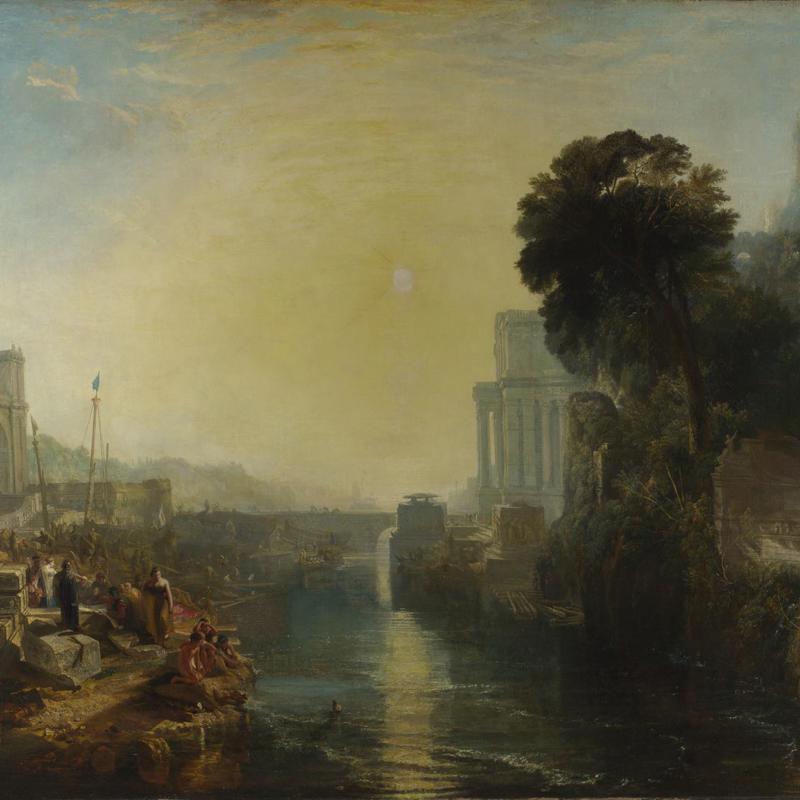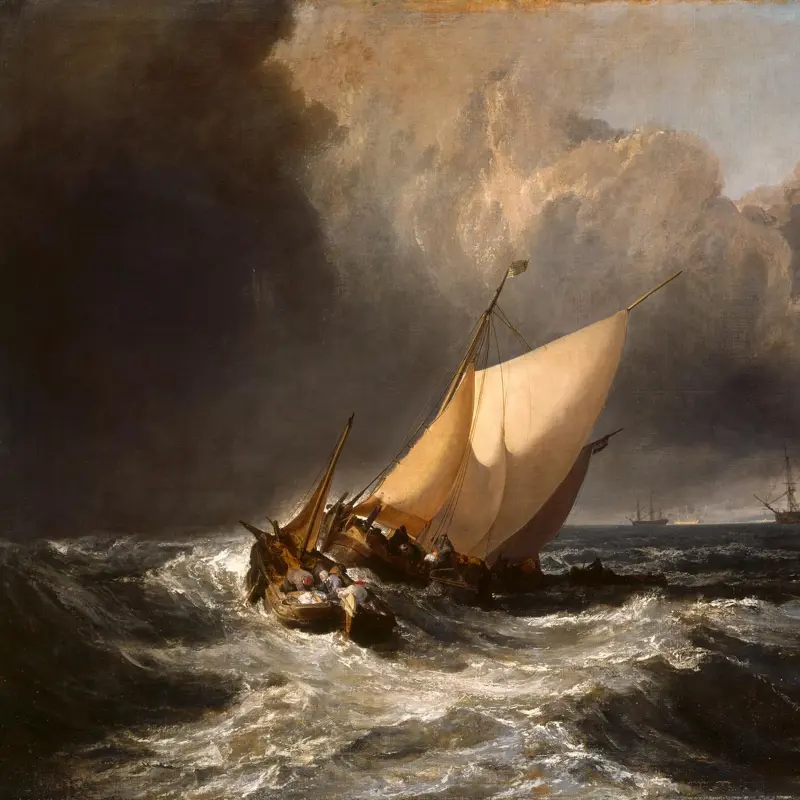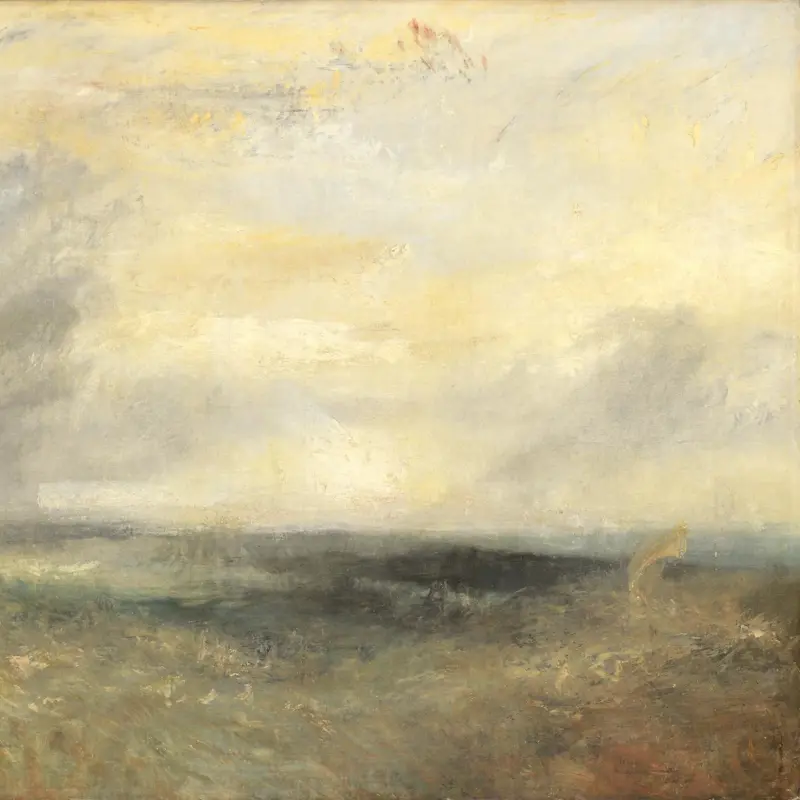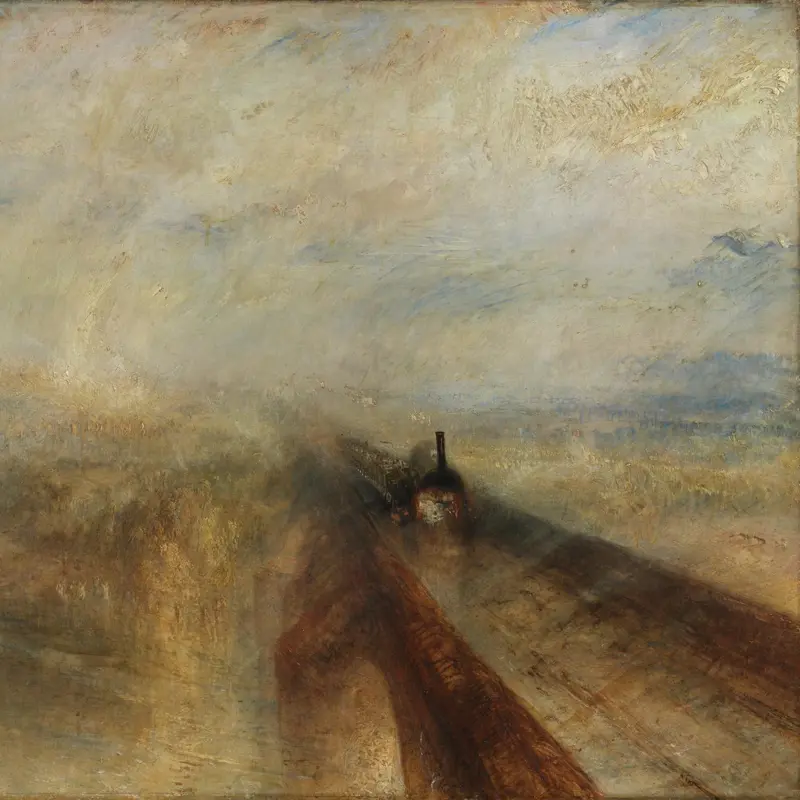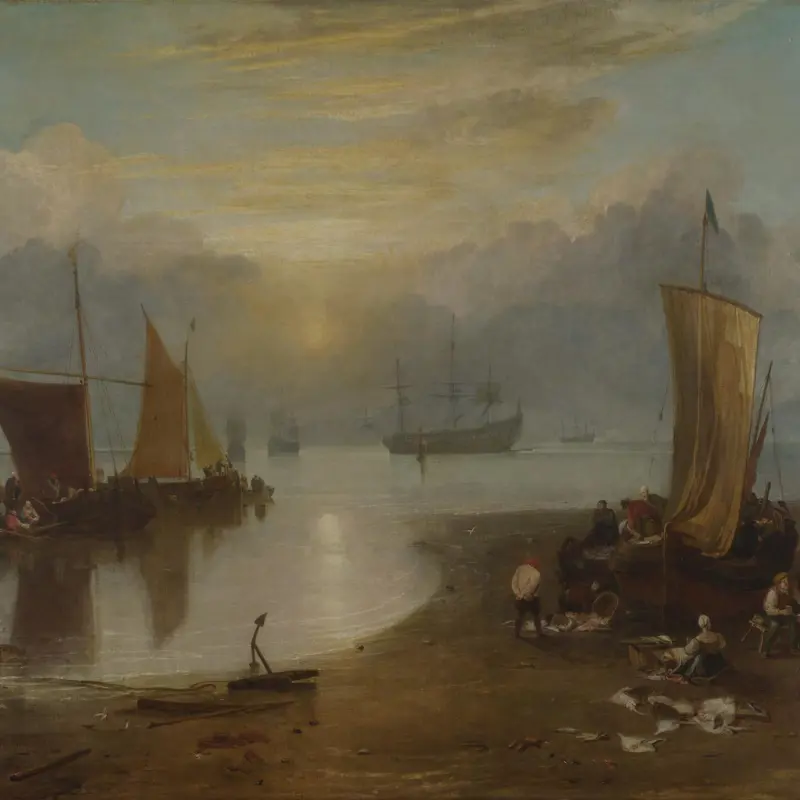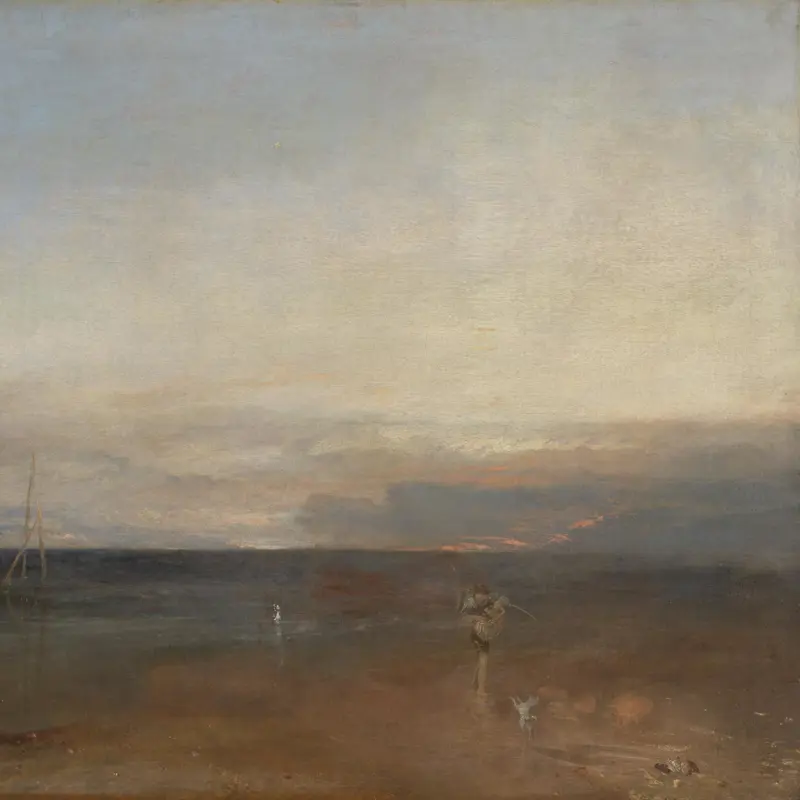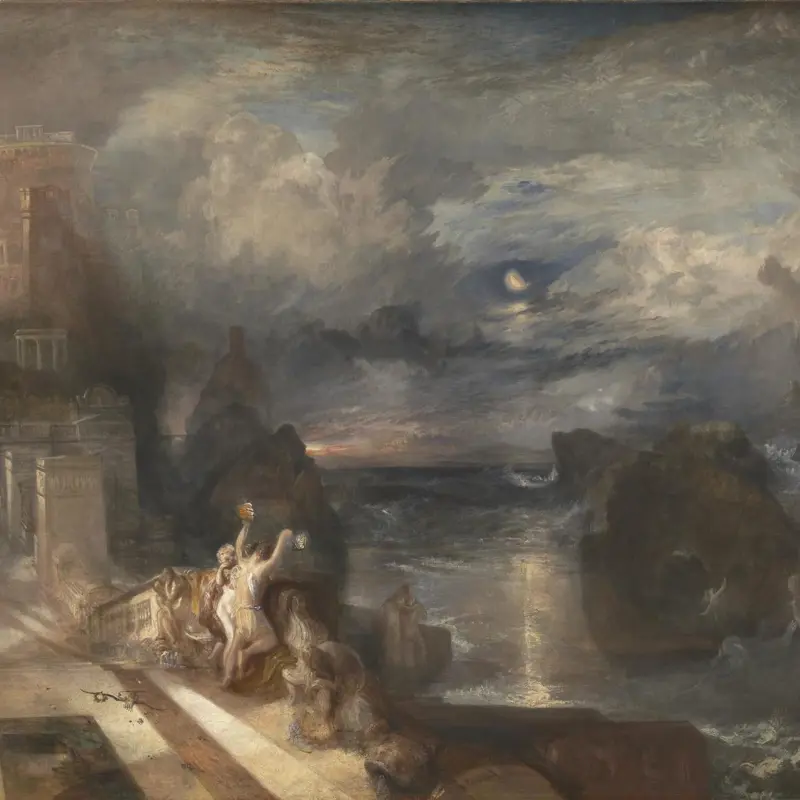Joseph Mallord William Turner, 'Dido building Carthage', 1815
About the work
Overview
Turner’s painting of the North African city of Carthage, founded by Dido, its first queen, was inspired by Virgil’s epic poem, the Aeneid. The figure on the left dressed in blue and wearing a diadem is Dido herself, visiting the tomb that is being built for her dead husband, Sychaeus. The man in a cloak and helmet standing before her is probably Aeneas, the hero of the poem, with whom she will fall in love. Turner painted 10 major paintings on the subject of the Carthaginian empire. The story of the rise and fall of empires was a theme that preoccupied him throughout his life.
This is the first of Turner’s paintings in which he set out to match the seventeenth-century French landscape painter, Claude, in particular Claude’s Seaport paintings. In his will, Turner specified that Dido building Carthage, together with his Sun Rising through Vapour, should be hung in the National Gallery alongside two of Claude’s paintings.
Key facts
Details
- Full title
- Dido building Carthage, or The Rise of the Carthaginian Empire
- Artist dates
- 1775 - 1851
- Date made
- 1815
- Medium and support
- oil on canvas
- Dimensions
- 155.5 × 230 cm
- Inscription summary
- Signed; Dated
- Acquisition credit
- Turner Bequest, 1856
- Inventory number
- NG498
- Location
- Not on display
- Collection
- Main Collection
- Previous owners
- Frame
- 19th-century English Frame (original frame)
Provenance
Additional information
Text extracted from the ‘Provenance’ section of the catalogue entry in Judy Egerton, ‘National Gallery Catalogues: The British Paintings’, London 2000; for further information, see the full catalogue entry.
Exhibition history
-
2009Turner and the MastersTate Britain23 September 2009 - 31 January 2010
-
2012Turner Inspired: In the Light of ClaudeThe National Gallery (London)14 March 2012 - 5 June 2012
Bibliography
-
1853Anon., 'Turner and Claude', Art Journal, V, 1853, p. 74
-
1853A.A. Watts, 'Biographical Sketch of J.M.W. Turner, Esq., R.A.', in Liber Fluviorum, London 1853
-
1857J. Ruskin, Notes on the Turner Gallery at Marlborough House, 1856, London 1857
-
1857R.N. Wornum, Descriptive and Historical Catalogue of the Pictures in the National Gallery, with Biographical Notices of the Painters: British School, London 1857
-
1860C.R. Leslie, Autobiographical Recollections, ed. T. Taylor, London 1860
-
1879P.G. Hamerton, The Life of J.M.W. Turner, R.A., London 1879
-
1895C.E. Smith, Journals and Correspondence of Lady Eastlake, London 1895
-
1902F. Goodall, Reminiscences, London 1902
-
1903J. Ruskin, Modern Painters, eds E.T. Cook and A. Wedderburn, The Works of John Ruskin, 39 vols, London 1903
-
1908W.G. Rawlinson, The Engraved Works of J.M.W. Turner, 2 vols, London 1908
-
1910A.J. Finberg, Turner's Sketches and Drawings, London 1910
-
1928W.T. Whitley, Art in England 1800-1820, Cambridge 1928
-
1930W.T. Whitley, Art in England 1821-1837, Cambridge 1930
-
1946Davies, Martin, National Gallery Catalogues: British School, London 1946
-
1946M. Davies, Paintings and Drawings on the Backs of National Gallery Pictures, London 1946
-
1951S. Cockerell, 'Letter', The Times, 1951
-
1959Davies, Martin, National Gallery Catalogues: British School, 2nd edn (revised), London 1959
-
1961A.J. Finberg and H.F. Finberg, The Life of J.M.W. Turner, R.A., 2nd revised edn, Oxford 1961
-
1963J. Ziff, 'Backgrounds: Introduction of Architecture and Landscape: Turner's Lecture First Given in 1811', Journal of the Warburg and Courtauld Institutes, XXVI, 1963, pp. 124-47
-
1974G. Wilkinson, The Sketches of Turner, R.A., 1802-1820, London 1974
-
1974J. Gage, Turner and Watercolour: An Exhibition of Watercolours Lent from the Turner Bequests at the British Museum (exh. cat. British Museum, April - September 1974), London 1974
-
1977K.D. Nicholson, J.M.W. Turner's Images of Antiquity, Phd Thesis, University of Pennslyvania 1977
-
1978A. Macintyre and K. Garlick (eds), The Diary of Joseph Farington, vol. 5, New Haven 1978-1984
-
1979V. Surtees, Reflections of a Friendship: John Ruskin's Letters to Pauline Trevelyan, London 1979
-
1980J. Ziff, 'Review: The Paintings of J. M. W. Turner by Martin Butlin, Evelyn Joll', Art Bulletin, LXII/1, 1980, pp. 166-71
-
1980M. Wilson, Claude: Embarkation of the Queen of Sheba and Turner: Dido building Carthage (exh. cat. The National Gallery, London, 14 February - 13 April 1980), London 1980
-
1980A. Wilton, Turner and the Sublime (exh. cat. Art Gallery of Ontario, 1 November 1980 - 4 January 1981; Yale Center for British Art, 11 February - 19 April 1981; British Museum, 15 May - 20 September 1981), Toronto 1980
-
1981W. Gaunt, Turner, Oxford 1981
-
1982M. Butlin and E. Joll, L'opera completa di Turner 1793-1829, Milan 1982
-
1982C. Powell, 'Infuriate in the Wreck of Hope: Turner's "Vision of Medea"', Turner Studies, II/1, 1982, pp. 12-8
-
1983M. Kitson, 'Turner and Claude', Turner Studies, II/2, 1983, pp. 2-15
-
1984M. Butlin and E. Joll, The Paintings of J.M.W. Turner, R.A., New Haven 1984
-
1987A. Wilton, Turner in his Time, London 1987
-
1988K. Nicholson, 'Style as Meaning: Turner's Late Mythological Landscapes', Turner Studies, II/2, 1988, pp. 45-54
-
1988J. Ziff, 'Turner as Defender of the Art Between 1810-20', Turner Studies, VIII/2, 1988, pp. 13-25
-
1990S. Ginzburg, Turner, New York 1990
-
1990K.D. Nicholson, Turner's Classical Landscapes: Myth and Meaning, Princeton 1990
-
1990E. Shanes, Turner's Human Landscape, London 1990
-
1990E. Shanes, Turner: The Masterworks, London 1990
-
1990G. Finley, 'Love and Duty: J.M.W. Turner and the Aeneas Legend', Zeitschrift für Kunstgeschichte, LIII, 1990, pp. 376-90
-
1990A. Wilton, Painting and Poetry: Turner's verse book and his works of 1804-1812 (exh. cat. Tate Gallery, 27 June - 16 September 1990), London 1990
-
1991J.A. Heffernan, 'Painting Against Poetry: Reynolds's Discourses and the Discourse of Turner's Art', Word and Image, VII, 1991, pp. 275-98
-
1994A. Thomas, An Illustrated Dictionary of Narrative Painting, London 1994
-
1997A. Bailey, Standing in the Sun: A Life of J.M.W. Turner, London 1997
-
1997J. Hamilton, Turner: A Life, London 1997
-
1997M.D. Rincón de Arellano, 'Turner visto por sus contemporáneos', Goya, 256, 1997, pp. 235-40
-
1997K.D. Kriz, 'Dido versus the Pirates: Turner's Carthaginian Paintings and the Sublimation of Colonial Desire', in M. Rosenthal, C. Payne and S. Wilcox (eds), Prospects for the Nations: Recent Essays in British Landscape, 1750-1880, New Haven 1997, pp. 231-60
-
1998J. Egerton, The British School, London 1998
-
1999G. Finley, Angel in the Sun: Turner's Vision of History, Montreal 1999
-
2000Egerton, Judy, National Gallery Catalogues: The British Paintings, revised edn, London 2000
-
2001
C. Baker and T. Henry, The National Gallery: Complete Illustrated Catalogue, London 2001
-
2002I. Warrell, Turner et le Lorrain, Paris 2002
About this record
If you know more about this work or have spotted an error, please contact us. Please note that exhibition histories are listed from 2009 onwards. Bibliographies may not be complete; more comprehensive information is available in the National Gallery Library.

